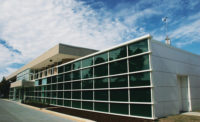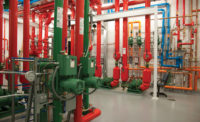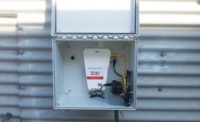Engineering and executing a fully functioning geothermal heating and cooling system on the first try is not only possible, it can be a downright pleasant experience. That is if the engineer, working with the property owner who has made the decision to use geothermal, follows some basic guidelines. A commercial geothermal system is no more complicated in execution than any other HVAC system and its benefits in terms of energy savings over a long operational life are greater than any other system.
With geothermal you will be taking advantage of your current customer base and skillset because geothermal exchange systems don’t necessarily change the mechanical system inside the building. However, the geothermal portion of the project may be new to you.
Getting started
First, a solid geothermal team needs to be assembled around the developer/owner’s engineering firm. Notice that I said “team,” meaning that some alliances need to be created. A geothermal team consists of all the parts to make a geothermal heating and cooling project come to fruition; and they’re likely right in your contact sphere. Regardless of the type of building involved and the scope of the project – a private residence, an office building or a whole campus or community – the parts will be much the same.
Depending on the project’s scope, you will likely need one or more other local professionals to assist you. Every geothermal heating and cooling project needs the following information and components assembled to be successful:
• A competent mechanical (geothermal HVAC) design;
• Geological conditions information;
• Construction knowledge;
• Equipment selection; and
• Execution of project.
With these five components assembled the project will be successful. Let’s expand on these five steps.
• Once you’ve identified a building project that you’d like to heat and cool, especially if this is your first time, you’ll need to find a geothermal exchange professional that has experience. This may be an MEP firm, or a drilling/loop contractor that has been accredited by the International Ground Source Heat Pump Association (IGSHPA). Oftentimes, this same entity can perform the installation of the geothermal exchange piping, but not necessarily. The best resources for geothermal HVAC professionals can be found at the Geothermal Exchange Organization (GEO) and the International Ground Source Heat Pump Association (IGSHPA). Always consult a few geothermal professionals so that you may consider the best fit for your needs. You’ll notice quickly that beyond the earth-coupled portion of a geothermal HVAC system, the overall design for the building will be much like a typical HVAC system.
• The geological component is important because you’ll be working with the earth through ground coupling. There are many good design options available, but one of them will favor your conditions more than others. It may be that the IGSHPA-accredited designer you’ve identified has competent data, which can be a bonus. Oftentimes, a hydrogeologist will be a great investment in making this a smooth process.
• Construction knowledge for geothermal heating and cooling is important. Your firm likely has good construction knowledge of mechanical/HVAC design in your area. You’ll want to work with someone who brings experience with the ground-coupled portion of the job and the credentials to go along with it.
• Whether you have chosen distributed GHPs, or a chiller-based design, equipment selection can be confusing. Look for a manufacturer that is able to support you technically as well as having the right equipment for the job.
• Execution of the project will be easier when you have a ready reference guide or a consultant to which you may refer for guidance. Just as important as a map, a good textbook with a good index such as “Modern Geothermal HVAC Engineering and Controls Applications” (McGraw-Hill Education 2013) will prove to be a welcome reference.
Some elaboration on your project
With this pattern in place, you will have assembled your own personal geothermal dream team, even if it’s just your company and one competent geothermal exchange professional that has good experience in earth-coupled design, geological conditions, construction and follow through.
A geothermal heat pump comes in numerous configurations, providing nearly limitless possibilities for distributed geothermal systems. If your project uses mechanical rooms, vertical GHPs may fit the bill. If you have a plenum ceiling and space restrictions, a good selection of horizontal configurations will be a benefit. However, there are many projects that may want to utilize radiant heat, chilled beams and dedicated outdoor air systems. Additionally, your project may have the opportunity to heat swimming pools or spas, and provide for domestic hot water needs. Geothermal systems are able to meet all of these demands and more.
Versatility is a benefit of GHP’s
• Water to water (for radiant heating and fan-coil cooling/heating);
• Unitary or split (the GHP typically fits neatly in an AHU-like
package, but can be configured like a split system);
• Hot water generators (a thing of the past for most HVAC systems);
• Internal circulating pumps (one less thing to worry about);
• Hot gas reheat/bypass (for dehumidification); and
• Cupro-nickel coaxial exchangers (important for certain
well-sourced applications).
Geothermal heat pumps are typically water-sourced heat pumps and because they are water sourced, you have the opportunity to extract or reject heat easily to/from other systems in the project. For example, consider summertime air conditioning. The GHP will be in the mode in which it is rejecting heat back to the earth. If this energy is routed through another heat exchanger for a pool or domestic hot water heat pump, your system will become hyper efficient as the process takes advantage of thermal load sharing.
Geothermal is in your future
Like many others who have engaged in geothermal projects for the first time, the first few geothermal undertakings will be scrutinized closely. Once you’ve had experience with geothermal installations, a level of comfort is achieved. Along the way, you can become certified as a geothermal professional recognized by IGSHPA and GeoExchange and get listed on their websites: this can open new doors to a greater number of prospective clients wishing to use your services for their geo-based projects.
Rest assured: Geothermal heating and cooling systems are not just a fad or a gimmick. Earth coupling is a proven, half-century-old technology that’s quickly becoming mainstream. Geothermal technology is recognized as a renewable energy technology, similar to solar or wind power. The U.S. Department of Energy recognizes geothermal as the most energy-efficient heating and cooling technology available.
In November 2014, Suffolk County, N.Y., adopted the first Uniform Geothermal Exchange Code in New York state, and perhaps the country. Other counties and states will be quickly following suit, making right now the perfect time to get into geothermal technologies. Even with millions of systems installed nationally and worldwide, there’s still plenty of room to grow.
At the IGSHPA conference in Baltimore last October, Bosch Thermotechnology of North America President Richard Soper pointed out that the number of accredited geothermal professionals will need to grow tenfold in order to handle the growing demand in the years ahead.
If you haven’t encountered geothermal yet, you certainly will in the future.
HELPFUL LINKS:






